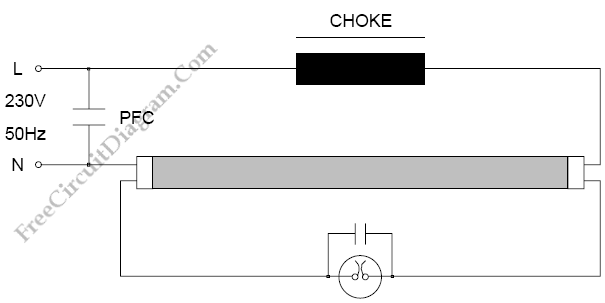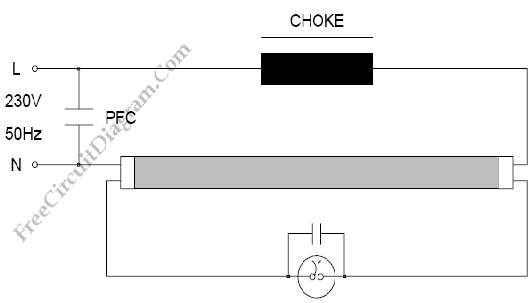Switchstart Ballast Circuit for Fluorescent Tube Lamp

Simplicity, low cost and improved efficiency when compared with the alternative options are the reasons why the switchstart circuit has been widely adopted. Moreover, the 230V mains voltage is sufficiently higher than tube running voltage to let the use of the simple series impedance ballast in almost every case. Where the mains voltage is not high enough, for example in most 120V supplied circuits, a quickstart circuit incorporating voltage step-up is used to control the lamp.

The lamp doesn’t light on first when the voltage is applied to the circuit, so the full mains voltage shows up across the starter via the choke and lamp cathodes. The starter is made of bi metallic contacts sealed within a small discharge bulb with an inert gas filling. The gas could be argon or neon. A glow discharge within the starter is caused by the mains voltage. This will heats up the bi metallic contacts, causing them to approach each other. When the bi metallic stay close, this will let preheat current to run through the choke and both cathodes.
The bi metallic contacts cool down and open since the glow discharge within the starter has now ceased. The voltage across the lamp increases rapidly and hit the lamp because the inductance of the choke tries to preserve current flow. The starter’s contacts close again and the cycle repeats if it doesn’t happen.
Current and voltage are controlled by the choke to the correct levels since the lamp has started at the firs time. The lamp running current is enough to maintain the cathodes (heaters) hot and sending out electrons without the need for separate heater supplies, which would otherwise be wasteful of energy. The circuit remains open because there is not enough voltage to cause a glow discharge in the starter since the lamp’s running voltage is much less than the mains voltage. Leading current from the mains is drawn by power factor correction (PFC) to counterbalance for the lagging current drawn by the lamp circuit. [Source: NXP Application Note]